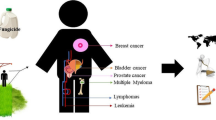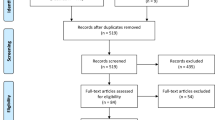Abstract
Objective
Terbufos is the fourth most commonly used organophosphate insecticide (OP) in the United States. Terbufos has not been demonstrated to be carcinogenic in rodents, although non-arsenical insecticides, including OPs, have been associated with excess cancer in epidemiologic studies. We investigated associations between use of terbufos and the incidence of cancer.
Methods
The Agricultural Health Study is a prospective cohort study of 57,310 licensed pesticide applicators from Iowa and North Carolina. Detailed information about 50 pesticides, including terbufos, and potential confounders was obtained from self-administered questionnaires. Terbufos intensity-weighted lifetime exposure-days were defined as (lifetime exposure-days) × (exposure intensity score). Cases include all first primary cancers diagnosed between enrollment and December 31, 2005. Hazard ratios (HR) and 95% CI were calculated with Cox proportional hazards models, adjusting for potential confounders.
Results
Overall cancer risk was slightly increased among terbufos users [HR 1.21 (1.06–1.37)]. Suggestive associations were observed between terbufos use and cancers of the prostate (HRhighest tertile = 1.21; 95% CI = 0.99–1.47) and lung (HRmiddle tertile = 1.45; 95% CI = 0.95–2.22) and leukemia (HRmiddle tertile = 2.38; 95% CI = 1.35–4.21) and non-Hodgkin’s lymphoma (HRmiddle tertile = 1.94; 95% CI = 1.16–3.22), although the exposure–response gradients were non-monotonic and p for trends were not significant.
Conclusion
We found suggestive associations between occupational terbufos use and several cancer sites. However, cautious interpretation of these results is warranted by the lack of existing experimental and epidemiologic evidence to support carcinogenic effects of terbufos.
Similar content being viewed by others
References
Kiely TDD, Grube A (2004) Pesticides industry sales and usage: 2000 and 2001 market estimates. U.S. Environmental Protection Agency, Washington, DC
USEPA (2001) Interim reregistration eligibility decision for terbufos, (Agency USEP)
Cambers JE, Carr RL, Boone JS, Chambers HW (2001) The metabolism of oragnophosphorus insecticides. In: Krieger RI (ed) Handbook of pesticide toxicology, vol 2, 2nd edn. Academic Press, New York, pp 919–927
McCall DL (1995) Revised human health assessment of terbufos, United States Enviornmental Protection Agency (Division OoPPHE)
Gentile JM et al (1982) An evaluation of the genotoxic properties of insecticides following plant and animal activation. Mutat Res 101(1):19–29
IARC (1991) Occupational exposures in insecticide application, and some pesticides. (International Agency for Cancer Research, Lyon, France)
Alavanja MC et al (2003) Use of agricultural pesticides and prostate cancer risk in the Agricultural Health Study cohort. Am J Epidemiol 157(9):800–814
Alavanja MC et al (2004) Pesticides and lung cancer risk in the Agricultural Health Study cohort. Am J Epidemiol 160(9):876–885
Engel LS et al (2005) Pesticide use and breast cancer risk among farmers’ wives in the Agricultural Health Study. Am J Epidemiol 161(2):121–135
Lee WJ et al (2007) Pesticide use and colorectal cancer risk in the Agricultural Health Study. (Translated from eng) Int J Cancer 121(2):339–346 (in eng)
Andreotti G et al (2009) Agricultural pesticide use and pancreatic cancer risk in the Agricultural Health Study Cohort. (Translated from eng) Int J Cancer 124(10):2495–2500 (in eng)
Lee WJ et al (2004) Cancer incidence among pesticide applicators exposed to chlorpyrifos in the Agricultural Health Study. J Natl Cancer Inst 96(23):1781–1789
Beane Freeman LE et al (2005) Cancer incidence among male pesticide applicators in the Agricultural Health Study cohort exposed to diazinon. Am J Epidemiol 162(11):1070–1079
Mahajan R et al (2006) Fonofos exposure and cancer incidence in the Agricultural Health Study. (Translated from eng) Environ Health Perspect 114(12):1838–1842 (in eng)
Cabello G et al (2001) A rat mammary tumor model induced by the organophosphorous pesticides parathion and malathion, possibly through acetylcholinesterase inhibition. Environ Health Perspect 109(5):471–479
Bagchi D, Bagchi M, Hassoun EA, Stohs SJ (1995) In vitro and in vivo generation of reactive oxygen species, DNA damage and lactate dehydrogenase leakage by selected pesticides. Toxicology 104(1–3):129–140
Galloway T, Handy R (2003) Immunotoxicity of organophosphorous pesticides. Ecotoxicology 12(1–4):345–363
Alavanja MC et al (1996) The Agricultural Health Study. Environ Health Perspect 104(4):362–369
Percy C, Van Holten V, Muir C (1990) International classification of diseases for oncology. World Health Organization, Geneva
Dosemeci M et al (2002) A quantitative approach for estimating exposure to pesticides in the Agricultural Health Study. Ann Occup Hyg 46(2):245–260
Maroni M, Colosio C, Ferioli A, Fait A (2000) Biological monitoring of pesticide exposure: a review. Introduction. Toxicology 143(1):1–118
SAS Institute I (2002–2003) SASCary, NC, USA
Mink PJ, Adami HO, Trichopoulos D, Britton NL, Mandel JS (2008) Pesticides and prostate cancer: a review of epidemiologic studies with specific agricultural exposure information. (Translated from eng) Eur J Cancer Prev 17(2):97–110 (in eng)
Breslow NE, Day NE (1987) Statistical methods in cancer research II—the design and analysis of cohort studies (IARC, Lyon, Fr.)
Cantor KP et al (1992) Pesticides and other agricultural risk factors for non-Hodgkin’s lymphoma among men in Iowa and Minnesota. Cancer Res 52(9):2447–2455
De Roos AJ et al (2003) Integrative assessment of multiple pesticides as risk factors for non-Hodgkin’s lymphoma among men. Occup Environ Med 60(9):E11
Brown LM et al (1990) Pesticide exposures and other agricultural risk factors for leukemia among men in Iowa and Minnesota. (Translated from eng) Cancer Res 50(20):6585–6591 (in eng)
Acquavella JF (1999) Farming and prostate cancer. Epidemiology 10(4):349–351
Blair A, Zahm SH (1995) Agricultural exposures and cancer. Environ Health Perspect 103(Suppl 8):205–208
Blair A et al (2002) Reliability of reporting on life-style and agricultural factors by a sample of participants in the Agricultural Health Study from Iowa. Epidemiology 13(1):94–99
Hoppin JA, Yucel F, Dosemeci M, Sandler DP (2002) Accuracy of self-reported pesticide use duration information from licensed pesticide applicators in the Agricultural Health Study. (Translated from eng) J Expo Anal Environ Epidemiol 12(5):313–318 (in eng)
Thomas KW et al. (2009) Assessment of a pesticide exposure intensity algorithm in the Agricultural Health Study. (Translated from Eng) J Expo Sci Environ Epidemiol (in eng)
Acknowledgments
This work was supported [in part] by the intramural research program of the National Institutes of Health, the National Institute of Environmental Health Sciences (Z01-ES049030-11), and National Cancer Institute (Z01-CP010119).
Author information
Authors and Affiliations
Corresponding author
Rights and permissions
About this article
Cite this article
Bonner, M.R., Williams, B.A., Rusiecki, J.A. et al. Occupational exposure to terbufos and the incidence of cancer in the Agricultural Health Study. Cancer Causes Control 21, 871–877 (2010). https://doi.org/10.1007/s10552-010-9514-9
Received:
Accepted:
Published:
Issue Date:
DOI: https://doi.org/10.1007/s10552-010-9514-9




